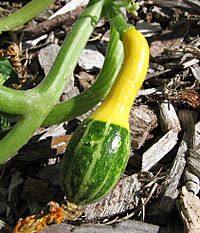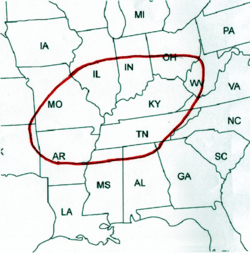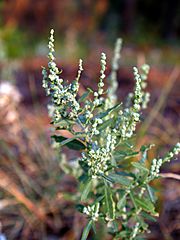Eastern Agricultural Complex facts for kids
The Eastern Agricultural Complex was one of about 10 independent centers of plant domestication in the pre-historic world. By about 1800 BCE the Native Americans of North America were cultivating several species of plants, thus transitioning from a hunter-gatherer economy to agriculture. After 200 BCE when maize from Mexico was introduced to the Eastern Woodlands, the Native Americans of the present-day United States and Canada slowly changed from growing local indigenous plants to a maize-based agricultural economy. The cultivation of local indigenous plants other than squash declined and was eventually abandoned. The formerly domesticated plants, except for squash, returned to their wild forms.
The initial four plants known to have been domesticated were goosefoot (Chenopodium berlandieri), sunflower (Helianthus annuus var. macrocarpus), marsh elder (Iva annua var. macrocarpa), and squash (Cucurbita pepo ssp. ovifera). Several other species of plants were later domesticated.
Term
The term Eastern Agricultural Complex (EAC) was popularized by anthropologist Ralph Linton in the 1940s. Linton suggested that the Eastern Woodland tribes integrated maize cultivation from Mayans and Aztecs in what is today called Mexico and Nicaragua into their own pre-existing agricultural practices. Ethnobotanists Volney H. Jones and Melvin R. Gilmore built upon Ralph Linton's understanding of Eastern Woodland agriculture with their work in cave and bluff dwellings in Kentucky and the Ozark Mountains in Arkansas. George Quimby also popularized the term "Eastern complex" in the 1940s. Authors Guy Gibbons and Kenneth Ames suggest that "indigenous seed crops" is a more appropriate term than "complex".
Cultivars
Squash (Cucurbita pepo var. ozarkana) is considered to be one of the first domesticated plants in the Eastern Woodlands, having been found in the region about 7,000 years ago, though possibly not domesticated in the region until about 3,000 years ago. The squash that was originally part of the complex was raised for edible seeds and to produce small containers (gourds), not for the thick flesh that is associated with modern varieties of squash. Cucurbita argyrosperma has been found in the region dated to circa 1300-1500 BCE. C. pepo cultivars crookneck, acorn, and scallop squash appeared later.
Other plants of the EAC include little barley (Hordeum pusillum), goosefoot or lambsquarters (Chenopodium berlandieri), erect knotweed (Polygonum erectum), maygrass (Phalaris caroliniana), sumpweed or marsh elder (Iva annua), and sunflower (Helianthus annuus).
The plants are often divided into "oily" or "starchy" categories. Sunflower and sumpweed have edible seeds rich in oil. Erect knotweed and goosefoot, a leafy vegetable, are starches, as are maygrass and little barley, both of which are grasses that yield grains that may be ground to make flour. (Note that erect knotweed is a distinct species from the Japanese knotweed (Reynoutria japonica) that is considered an invasive species in the eastern United States today.)
Domestication
Some of the species cultivated by Native Americans for food are today considered undesirable weeds. Another name for marshelder is sumpweed; chenopods are derisively called pigweed, although one South American species with a more attractive name, quinoa, is a health food store favorite. Many plants considered weeds are the colonizers of disturbed soil, the first fast-growing weeds to spring up when a natural or man-made event, such as a fire, leaves a bare patch of soil.
The process of domestication of wild plants cannot be described with any precision. However, Bruce D. Smith and other scholars have pointed out that three of the domesticates (chenopods, I. annua, and C. pepo) were plants that thrived in disturbed soils in river valleys. In the aftermath of a flood, in which most of the old vegetation is killed by the high waters and bare patches of new, often very fertile, soil were created, these pioneer plants sprang up like magic, often growing in almost pure stands, but usually disappearing after a single season, as other vegetation pushed them out until the next flood.
Native Americans learned early that the seeds of these three species were edible and easily harvested in quantity because they grew in dense stands. C. pepo was important also because the gourd could be made into a lightweight container that was useful to a seminomadic band. Chenopods have edible leaves, related to spinach and chard, that may have also been gathered and eaten by Native Americans. Chenopod seeds are starchy; marsh elder has a highly nutritious oily seed similar to sunflower seeds.

In gathering the seeds some were undoubtedly dropped in the sunny environment and disturbed soil of a settlement, and those seeds sprouted and thrived. Over time the seeds were sown and the ground was cleared of any competitive vegetation. The seeds which germinated quickest (i.e. thinner seed coats) and the plants which grew fastest were the most likely to be tended, harvested, and replanted. Through a process of unconscious selection and, later, conscious selection, the domesticated weeds became more productive. The seeds of some species became substantially larger and/or their seed coats were less thick compared to the wild plants. For example, the seed coats of domesticated chenopodium is less than 20 microns thick; the wild chenopodium of the same species is 40 to 60 microns thick. Conversely, when Native Americans quit growing these plants, as they did later, their seeds reverted within a few years to the thickness they had been in the wild.
By about 500 BCE, seeds produced by six domesticated plants were an important part of the diet of Native Americans in the middle Mississippi River valley of the Eastern Woodlands region.
Introduction of maize
The local indigenous crops were replaced slowly by other more productive crops developed by the Mesoamericans in what is now called Mexico: maize, beans and additional varieties of squash. Maize, or corn, was a relative latecomer to the Eastern Woodlands Cultures. The oldest known evidence of maize in what is now known as Mexico dates to 6700 BCE. The oldest evidence of maize cultivation north of the Rio Grande in use is by about 2100 BCE at several locations in what is now called Arizona and New Mexico.
Maize was first grown by Eastern Woodlands Cultures by around 200 BCE, and highly productive localized varieties became widely used around 900 CE. The spread was so slow because the seeds and knowledge of techniques for tending them had to cross inhospitable deserts and mountains, and more productive varieties of maize had to be developed to compete with local indigenous crops and to suit the cooler climates and shorter growing seasons of the northern regions. Tropical maize does not flower under the long day conditions of summer north of what is now called Mexico, requiring genetic adaptation. It seems that maize was adopted first as a supplement to existing local indigenous agricultural plants, but gradually came to dominate as its yields increased. Ultimately, the EAC was thoroughly replaced by maize-based agriculture. Most EAC plants are no longer cultivated, and some of them (such as little barley) are regarded as pests by modern farmers.
Images for kids





